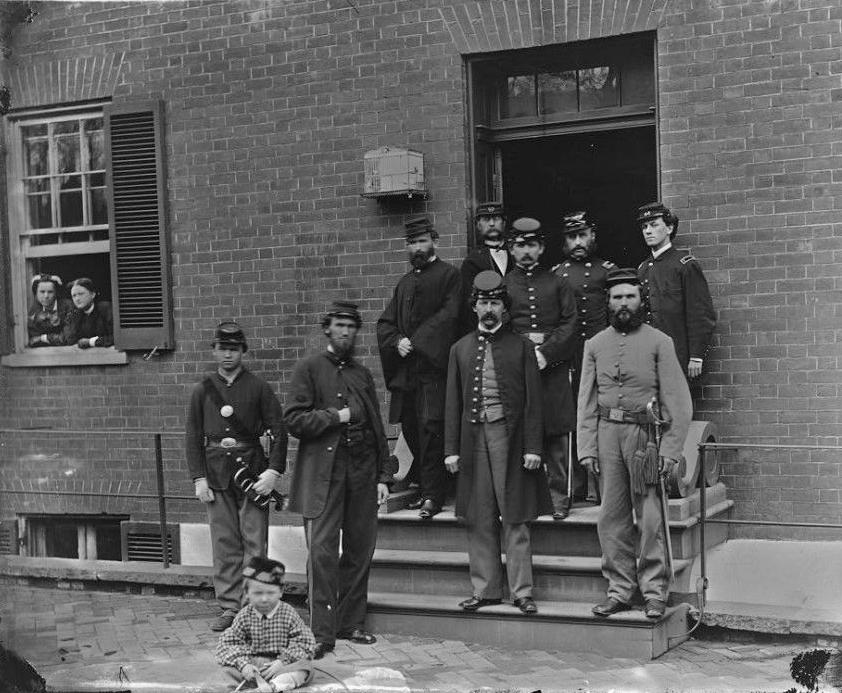
United States Civil War Fashion Trends: Garments

Figure 1.--This undated photograph from Washington D.C. shows group of Federal officers with a orderly/buggle boy, we think early in the War, probably about 1862. We think that they are standing outside of their boarding house. Note the women in the window. This may be a Matthew Brady photograph. One interesting detail is the little boy playing outside on the sidewalk, presumably the son of the ladyrunning the boarding house. Most images from the 1860s, especially of children are studio portraits for which they have been dressed up. Here we see how boys may have dressed on a normal day. In this case he seems to be wearing the shirts often worn as tunics in the 1850s which is why in addition to the uniforms we think the photograph was taken in the early-60s. He seems to be wearing a Glengary cap.
|
|
Fashion changes in boys clothing resulting from the war are more difficult to assess. We notice quite a nunber of fashion styles that did change. While there were no fundamental changes in boys' fashions after the War, there were some noticeable developments. Many of these changes appear to have Eurooperan origins. Some of the changes may have been related to the War, but we suspect that more important were the economic developments and expanding prosperity of a rapidly industrailizing United States. Rising prosperity gave Americans the ability to buy more fashionable clothes, including the styles originating from Europe. Here are some of the changes we have noted in specific garments. We see few direct war-time influences.
Headwear
Boys in the 1850s generally wore hats--full brimed headwear, although following the War with Mexico the peaked cap was also won. During and after the Civil War, various styles of caps became increasingly popular. We see siome boys wearing kempis, but it did not oriove to be a lasting stylefor boys except in military schools. Small boys increasingly wore wide-brimmed sailor hats after the War, but older boys were more commopnly seen in caps. We also see Scotish headwear, mostly Glengaries like the boy here is wearing which was a kind of military style (figure 1). The fashion influences seem more British thab Civil War influenced.
Dresses
The dresses worn by boys before breeching continued to be esentially the same as those worn by their sisters. HBC does not know if the custom of dressing boys and girls identically before the boys were breeched was affected by the War. Were boys still breeched ar about the same age before and after the War. Notably the fashion of boy dresses, dressed especially styled for boys, appeaed in the 1870s.
Kilts
Boys wearing kilts are more moticeable during the 1860s, but not nearly to the degree apparent in the 1870s. Here there seens no connection with the military fasgion and the Civil War. This seems more a Britisg fashion influence. Some units wore French-styled Zouave unifiorms, but we know of not kilted units. The Iruish brigades maybhave had kilted pipers. We are not sure of this. Tghe Gkengary was to an extebt associated with the kilt suits.
Jackets
Somewhat surprisingly, a major military style, the collar-buttoning military jacket with multiple bittons went out of style during the Civil War era. It was an important boys' style in the 1840s and 50s and we stull see it in the early-60s, but it becomes much less common after the War. At the same tinme, must simpler cut-away jackets become popular for younger boys. Perhaps this was related to the cut-away jackets worn with Zouave uniforms. The cut-away jacket largely replaced the military styled collar buttoning jacket.
Military Styles
Boys and men's fashions are often affected by military styles. Boys as a result of the War began to wear clothes will military styles or at least influenced by military uniforms. Suits with bagging trousers influenced by the Zouave style coming out of French Algeria appeared in the 1850s. With the appearance of Zouave units in the early years of the War, this style became quite popular in the 1860s. The sailor suit also apeared in America during the 1860s although it was still not commony worn until the 1870s. Double breasted clothing is seem during the Civil War, but this was not a new military-influenced style.
Tunics
The style of boys wearing tunic-like shirts does appear to have gone out of fashion at about the same tome as the War. We see more destictive tunic garments.
Pants
Boys during the Civil War mostly wore long pants. Knee pants and knickers, however, did appear in the 1860s, especially among wealthy families more in tune with European fashions. By the end of the 1860s, knee pants were becoming more popular, aticipating the 1870s when knee pants became more accepted as a style for younger boys. There seems to be no connection with the Civil War, but more with European fasgion trends. We see no impat of the baggy trousrs wirn as oart of Zouave unifirms.
HBC

Navigate the HBC Civil War related pages
[Return to the Main Civil War page]
[Return to the Main Civil War fashion page]
[Return to the Main U.S. 1860s page]
[Return to the Main 1860s page]
[Return to the Main U.S. page]
[Biographies]
[Campaign]
[Causes]
[Emancipation]
[Families and youth]
[Fiscal policy]
[Formations and units]
[Law]
[Railroads]
[Slavery]
[Soldiers]
[Uniforms]
[Weaponry]
[Importance]
[Lost Cause]
[Civil Rights movement]
Created: 3:38 AM 1/26/2014
Last updated: 6:24 PM 9/14/2015



